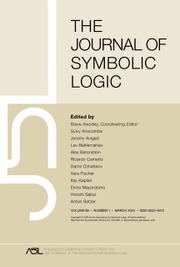Article contents
Jump inversions inside effectively closed sets and applications to randomness
Published online by Cambridge University Press: 12 March 2014
Abstract
We study inversions of the jump operator on  classes, combined with certain basis theorems. These jump inversions have implications for the study of the jump operator on the random degrees—for various notions of randomness. For example, we characterize the jumps of the weakly 2-random sets which are not 2-random, and the jumps of the weakly 1-random relative to 0′ sets which are not 2-random. Both of the classes coincide with the degrees above 0′ which are not 0′-dominated. A further application is the complete solution of [24, Problem 3.6.9]: one direction of van Lambalgen's theorem holds for weak 2-randomness, while the other fails.
classes, combined with certain basis theorems. These jump inversions have implications for the study of the jump operator on the random degrees—for various notions of randomness. For example, we characterize the jumps of the weakly 2-random sets which are not 2-random, and the jumps of the weakly 1-random relative to 0′ sets which are not 2-random. Both of the classes coincide with the degrees above 0′ which are not 0′-dominated. A further application is the complete solution of [24, Problem 3.6.9]: one direction of van Lambalgen's theorem holds for weak 2-randomness, while the other fails.
Finally we discuss various techniques for coding information into incomplete randoms. Using these techniques we give a negative answer to [24, Problem 8.2.14]: not all weakly 2-random sets are array computable. In fact, given any oracle X, there is a weakly 2-random which is not array computable relative to X. This contrasts with the fact that all 2-random sets are array computable.
Information
- Type
- Research Article
- Information
- Copyright
- Copyright © Association for Symbolic Logic 2011
References
REFERENCES
- 6
- Cited by

